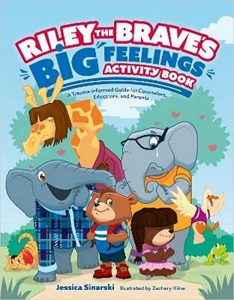Q&A with Jessica Sinarski, LPCMH Author of Riley the Brave’s Big Feelings Activity Book
Q&A with Jessica Sinarski, LPCMH
 Author of Riley the Brave’s Big Feelings Activity Book
Author of Riley the Brave’s Big Feelings Activity Book
Question: What are the benefits of presenting the information in Riley the Brave’s Big Feelings as an activity book rather than a regular children’s book?
Jessica Sinarski: Over the past few years, my waiting list as a therapist was getting longer and longer. More children are beginning to deal with mental health issues for various reasons, and it can be inaccessible for many families to get the care and support their child needs.
There is also a shortage of truly trauma-informed resources for home, school, and community use. Many mental health professionals are stuck with outdated material that does not reach the parts of the brain that are impacted by trauma. Similarly, social emotional learning curriculum often misses the kids who need it most. I hope that having this more comprehensive illustrated guide will help bridge the gap, translating complicated brain science into a deceptively simple book full of engaging activities, beautiful visuals, and even some helpful scripts for parents, teachers, and other caring adults.
Q: Why is it important to make brain science understandable and accessible to both caregivers and children?
JS: As a mom, I know how easy it is to get stuck just focusing on behavior, especially the behavior we don’t like! My whole world changed when I started to really understand that all behavior comes from the brain. Digging into what is really going on in the brain helped me understand my kids (and myself) a lot better! But it didn’t stop there. This new brain-based lens transformed my work as a mental health counselor. I realized why a lot of the well-intentioned strategies I had been taught in graduate school left people still feeling misunderstood, hurt, and alone. We weren’t reaching the part of the brain that needed compassionate support!
Suddenly I felt like I had magic brain goggles that gave me x-ray vision into what was underneath challenging behavior. I want everyone to have that, and I want to start young! That’s why I created the Riley the Brave series to help make this complicated inner world visible for readers as young as 3 or 4. I’ve also heard from older adults that having these simple visuals and analogies helped them understand themselves better.
At the end of the day, everyone just wants to feel safe, seen, and valued. User-friendly brain science, surprisingly, can help make that possible.
Q: Throughout Riley the Brave’s Big Feelings Activity Book you use the terms “upstairs brain” and “downstairs brain.” What do those terms mean and how are they helpful?
JS: The terms come from Dr. Daniel Siegel’s “house model of the brain.” In this concept, there are two main parts of the human brain, the “upstairs” and “downstairs.” A person’s thoughts, feelings, and actions depend on which part is in control at the time. Our “upstairs brain” helps us do things like care about others, manage strong emotions, and think things through.
The “downstairs brain,” on the other hand, is all about survival. It can help you stay safe in tough situations, but can also be difficult to get out of that instinct-driven state. When children are in their “downstairs brain”, they can be irritable, defiant, withdrawn, aggressive, or all those things at once! They often need a safe adult to help them find their way back to their “upstairs brain.” Unfortunately, a brain that is in survival mode is not very good at figuring out who is safe and how to get help. So, a child may continue to lash out even as you offer help. This leaves caring adults hurt, frustrated, and more likely to end up in their “downstairs brain.”
Knowing these terms helps us understand why children might be “acting out” or having a hard time emotionally regulating on their own.
Q: A lot of your work focuses on helping parents and schools incorporate trauma-informed practices into their lives and work. What are some practices that caregivers can start in their everyday lives when they begin their work in trauma-informed care?
JS: First, we have to understand that the brain speaks nonverbal. What I mean by that is your facial expression, tone of voice, and body posture all have a much greater impact on what you child “hears” than the words you say. It’s true for adults too! Sometimes I have to ask my husband to lower his eyebrows so that I can hear what he is trying to say without feeling like his face is yelling at me. Mustering some warmth in your eyes and staying away from harsh scolding and angry lectures is a great first step.
Secondly, practice the pause. We have all said things in the heat of the moment that we regret. When you feel your heart pounding or steam about to come out of your ears, pause. This helps your upstairs brain have time to weigh in on the situation. Here’s a rhyme I shared in Hello, Anger to help kids and adults remember:
“Stop when I’m furious.
Pause and be curious.
What is underneath the mad?
Am I lonely, stressed, or sad?”
Third, work on your own “upstairs brain action plan.” When your survival brain takes over, what can help you get your calm, curious, compassionate thinking brain back online? A deep breath, a helpful mantra, a cold glass of water? Sometimes I need a quick text with a friend who gets it so I don’t take my frustration out on the kids in front of me. It takes practice, but managing our own big feelings is essential if we want to support kids who have been impacted by trauma.
Why is helping families navigating the foster care system a particular passion of yours?
The foster care system is often overlooked. I started my career as a bright-eyed counselor working at a social service agency in the South Bronx, and all the great therapeutic skills I had learned in graduate school were not helping. It was overwhelming and messy, with broken systems, fractured relationships, and destructive behaviors all around. But under all the angry outbursts there was layer after layer of pain, fear, and paralyzing shame.
It set me on a a path to learn why those problematic behaviors were really happening and what we can do about it. I found the answers in an unexpected place: brain science. And those same answers were helping me understand my own trauma history as well.
What if all behavior makes sense?
What if the same things that keep kids alive get them in trouble later?
What if we can celebrate the courage of survival and the courage of choosing the vulnerable path of healing and trust?
Unfortunately, most training for social workers, foster and adoptive parents, birth and kinship parents, and all the teachers, counselors, and therapists supporting these families was not incorporating this life-giving science. I am passionate about filling that gap, distilling complex topics into relatable stories, helpful visuals, and “aha” moments for everyone involved.
I spent much of my life feeling broken and have seen harmful misinformation about the path to wholeness. Now I get to empower the healers and cycle-breakers.
ABOUT THE AUTHOR
Jessica Sinarski, LPCMH (licensed professional counselor of mental health) is a highly sought-after therapist, speaker, and change-maker. Weaving user-friendly brain science into everything she does, Jessica ignites both passion and know-how in audiences. Extensive post-graduate training and 15+ years as a clinician and educator led her to create the resource and training platform BraveBrains. She partners with school districts and child welfare agencies around the world to unlock resilience in children and adults alike.
Jessica makes social emotional learning (SEL) practical, equipping parents and professionals with deeply trauma-informed tools. She is the author of the award-winning Riley the Brave series, Your Magic Backpack series, and the forthcoming Light Up the Learning Brain (Sept. 2023). She also shares her expertise as a contributor to magazines, blogs, and podcasts. Jessica lives in Pennsylvania with her husband and three busy boys.
To learn more about Jessica Sinarski please visit www.jessicasinarski.com or www.bravebrains.com and connect on Facebook, Instagram, and Twitter.
Riley the Brave’s Big Feelings Activity Book
 Roaring, grumping, knots in tummies…Making sense of big feelings can be tricky. Riley the Brave and his safe big critters are here to help! Enjoy 60+ fun activities and trauma-sensitive strategies to help children understand the brain science behind those big MAD, SAD, and SCARED emotions…and what to do about it!
Roaring, grumping, knots in tummies…Making sense of big feelings can be tricky. Riley the Brave and his safe big critters are here to help! Enjoy 60+ fun activities and trauma-sensitive strategies to help children understand the brain science behind those big MAD, SAD, and SCARED emotions…and what to do about it!
Bright illustrations and familiar characters encourage children as they dig into their prickly porcupine moments, timid turtle moments, and all the feelings in between. An introduction for grown-ups will help you make the most of this treasure trove of games, printable masks, colorful cards, word searches, action plans, and more! Work one-on-one or easily adapt these strength-based activities for group settings. Lesson plans and frequent “Try This!” sections make this the ultimate resource for parents, teachers, counselors, and anyone else supporting children with big feelings.
Riley the Brave’s Big Feelings Activity Book is available from independent booksellers, Bookshop.org, Amazon and other retailers.
Category: On Writing























